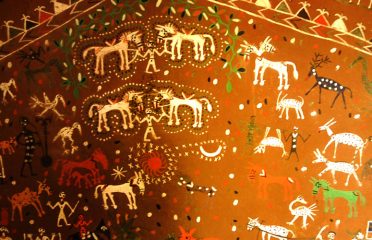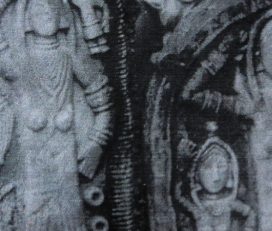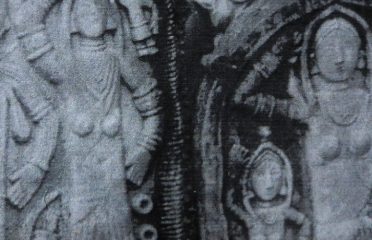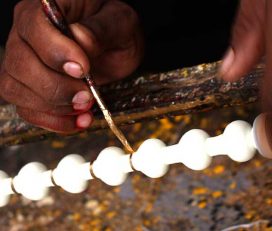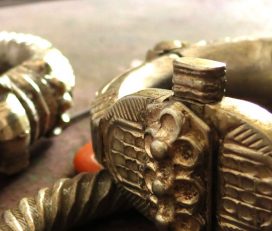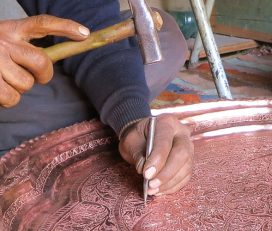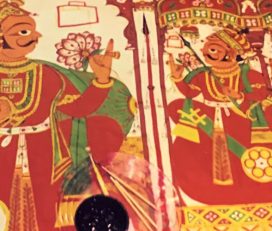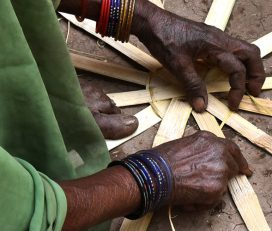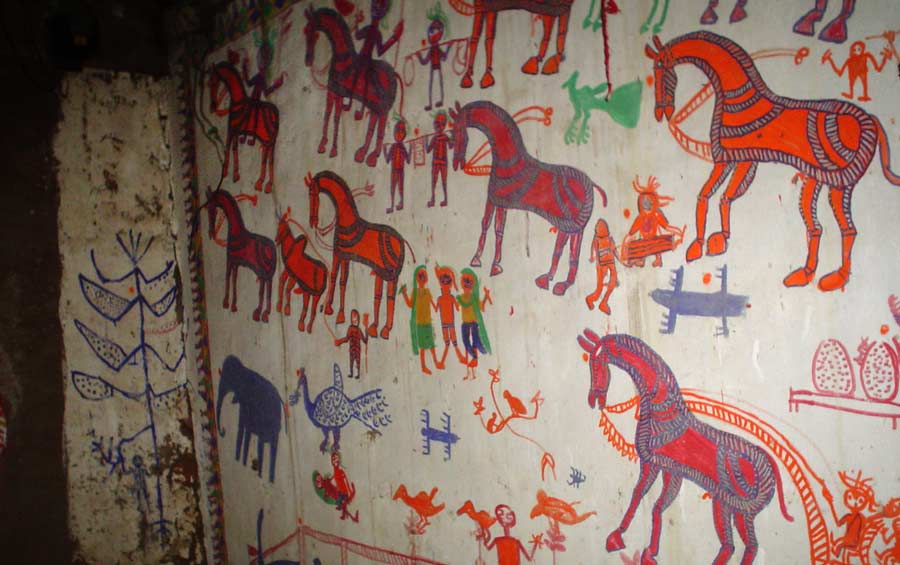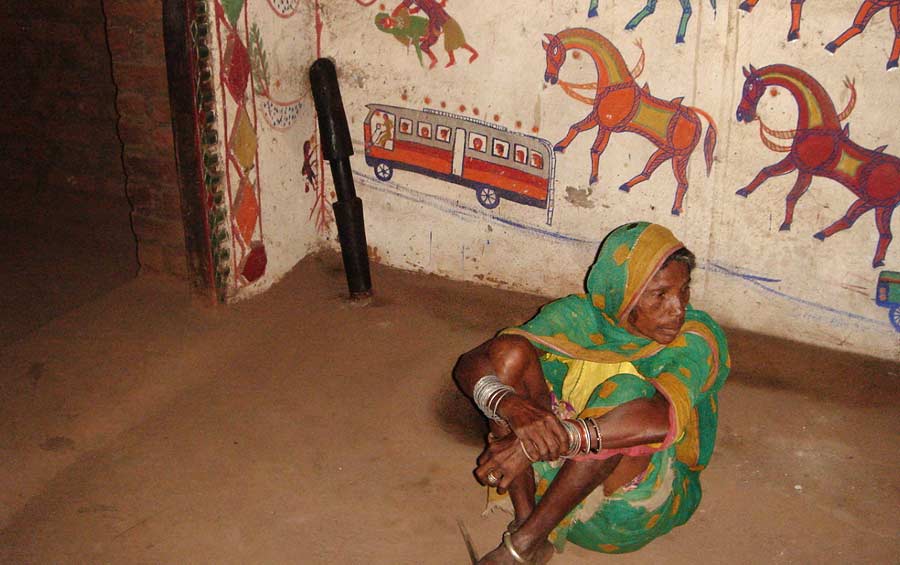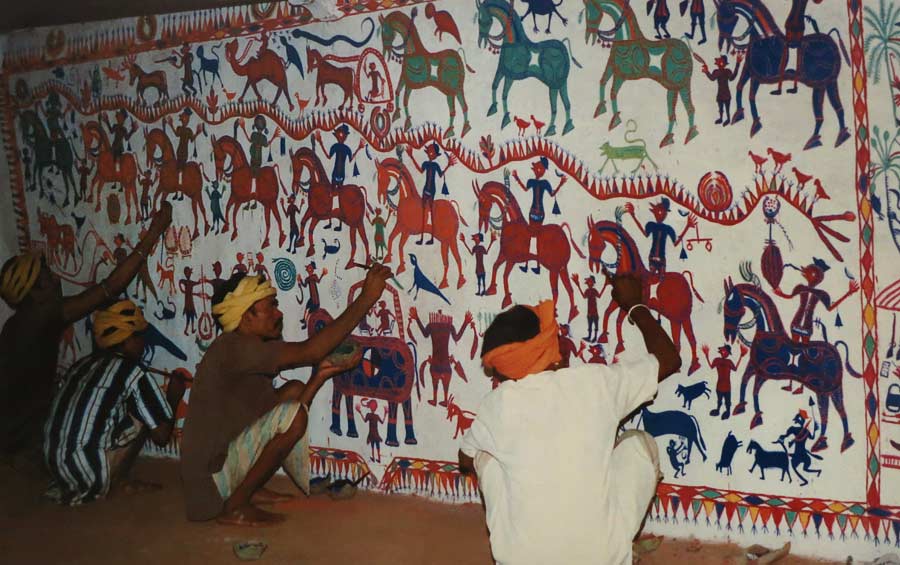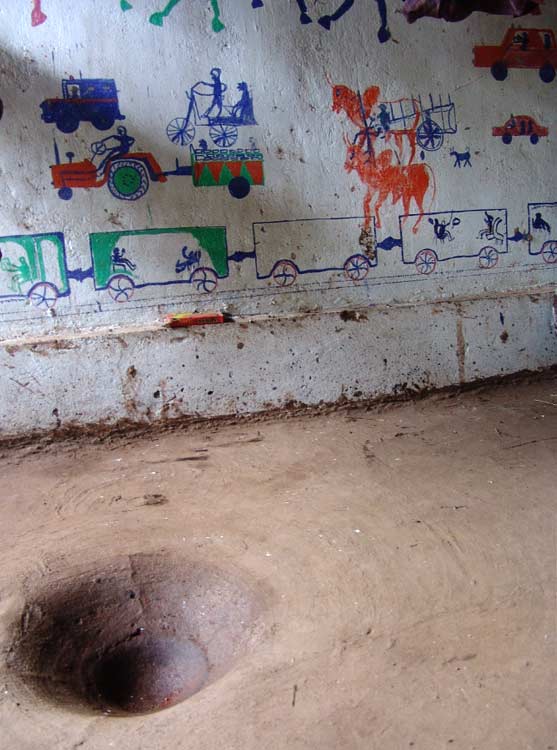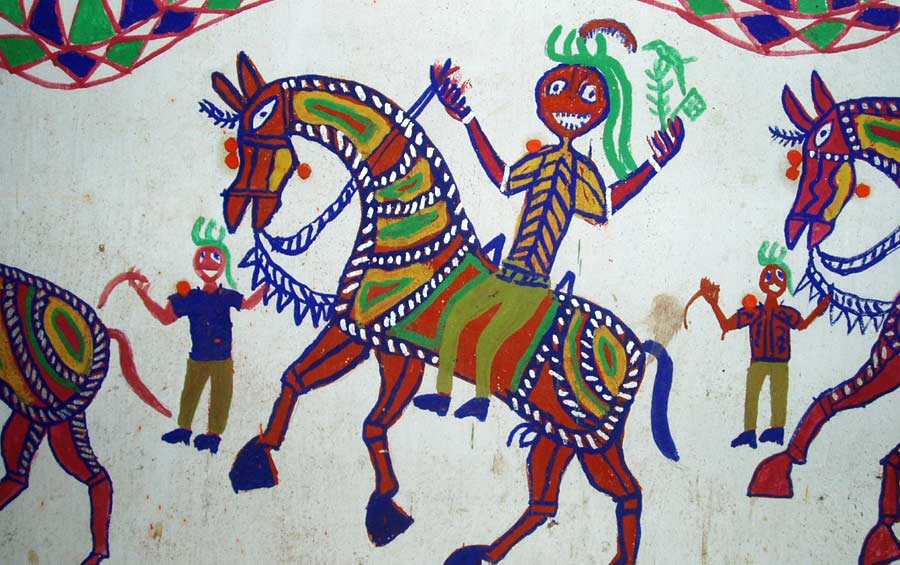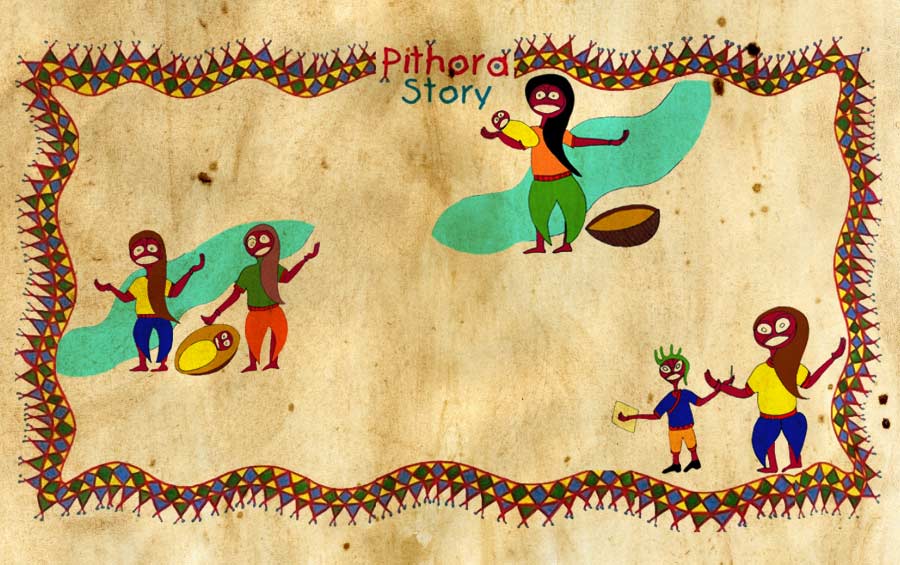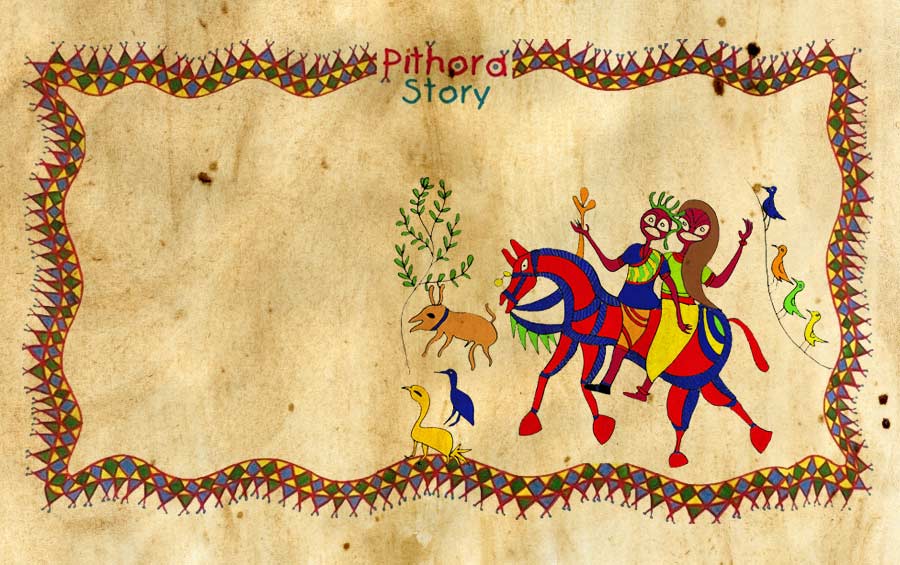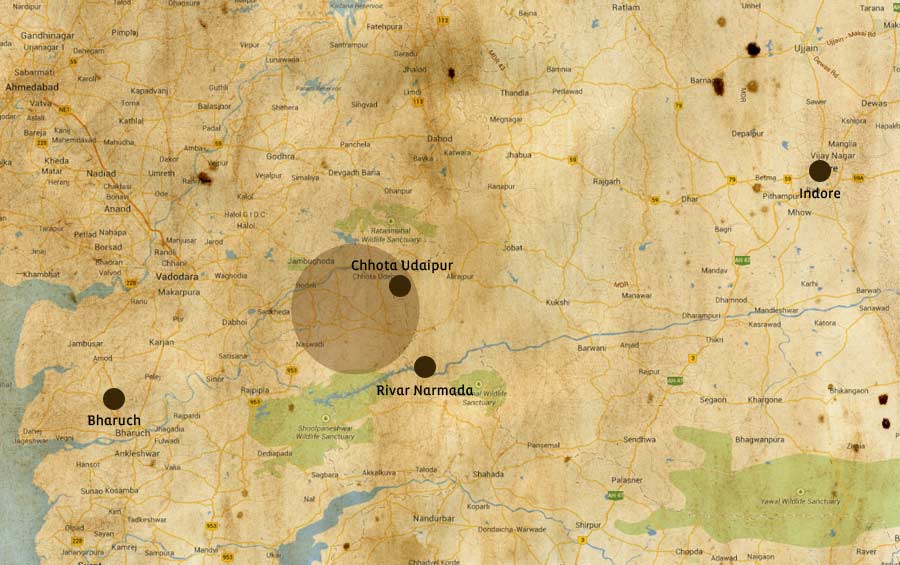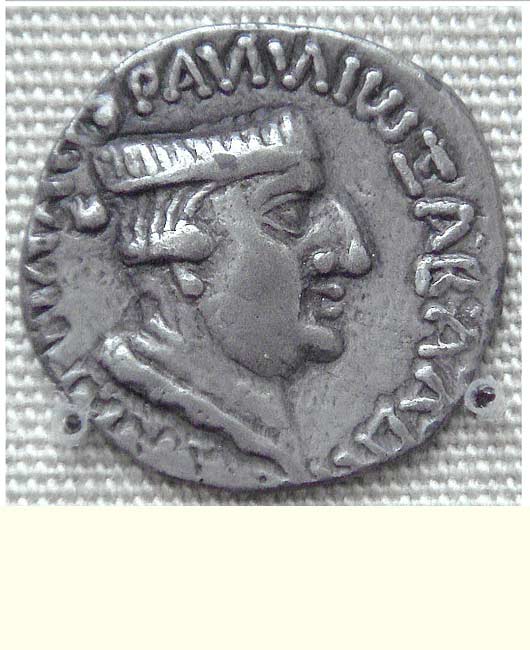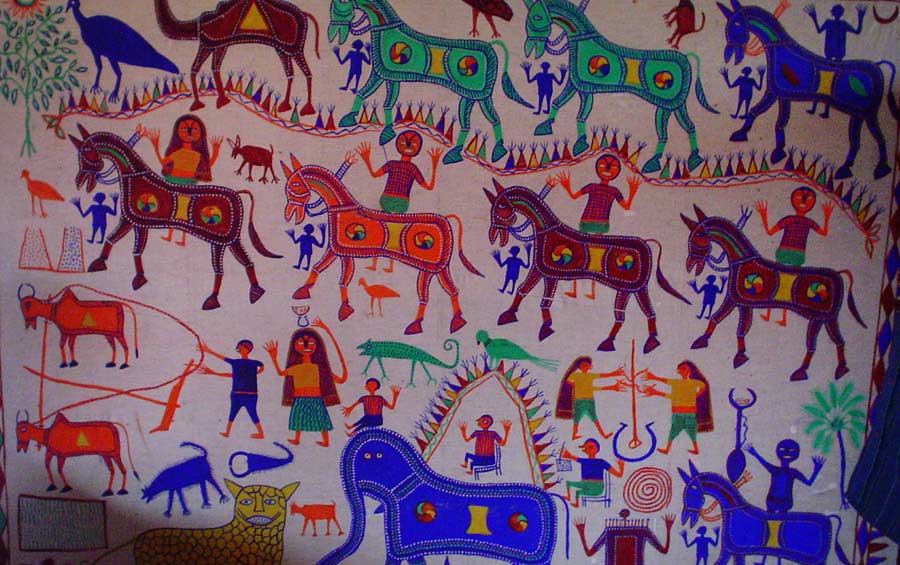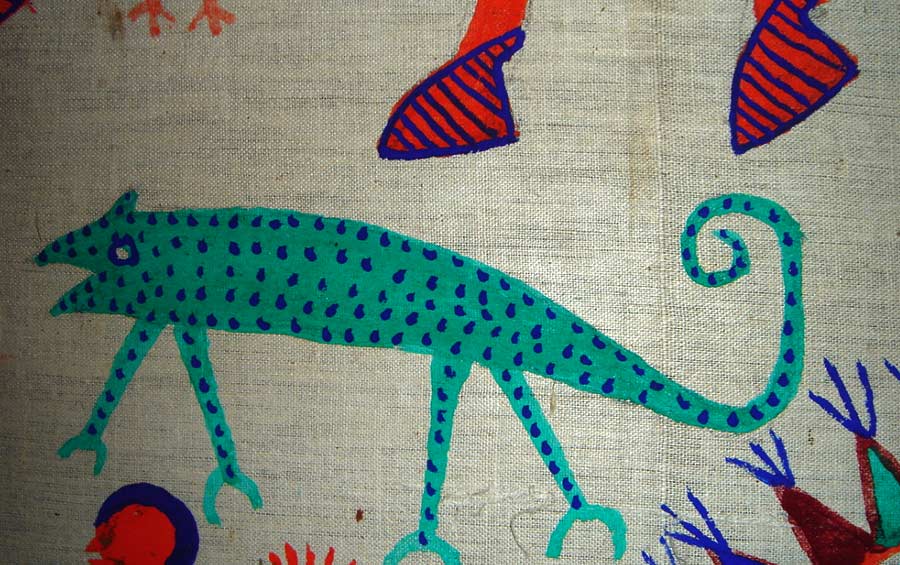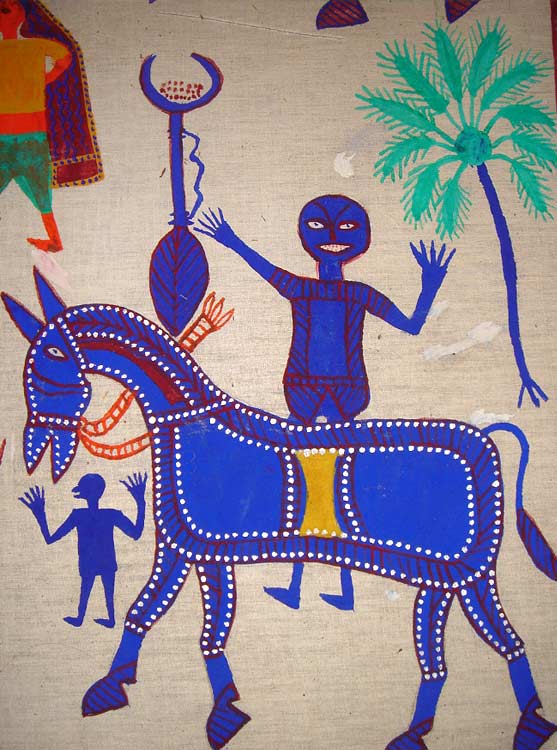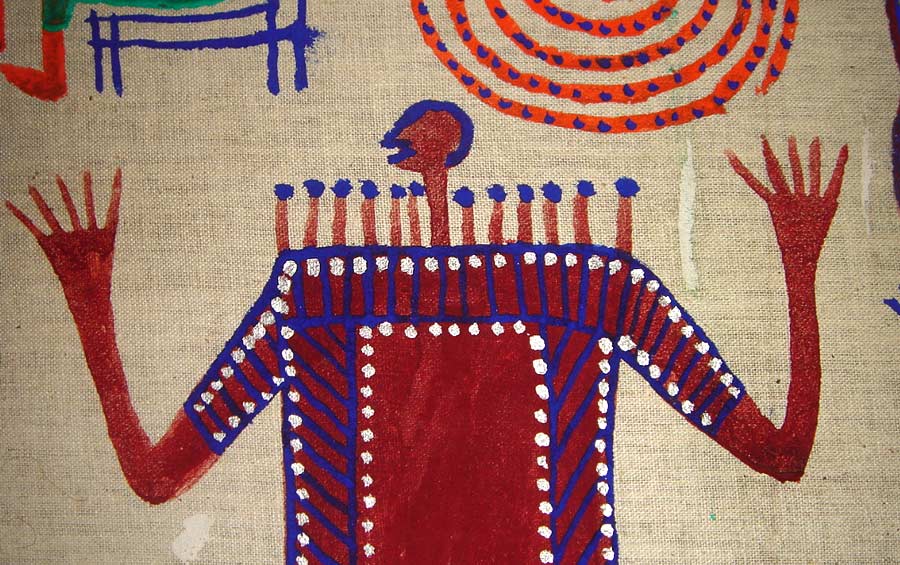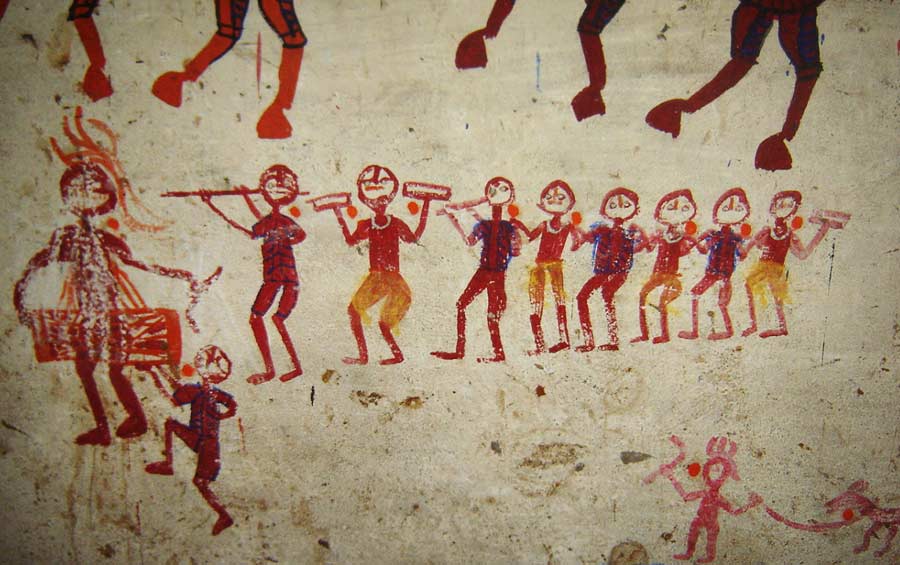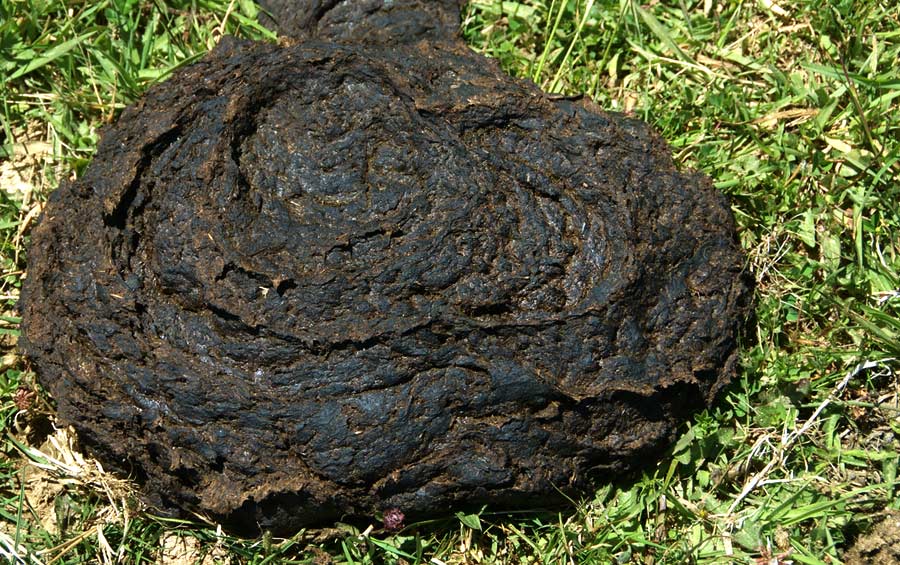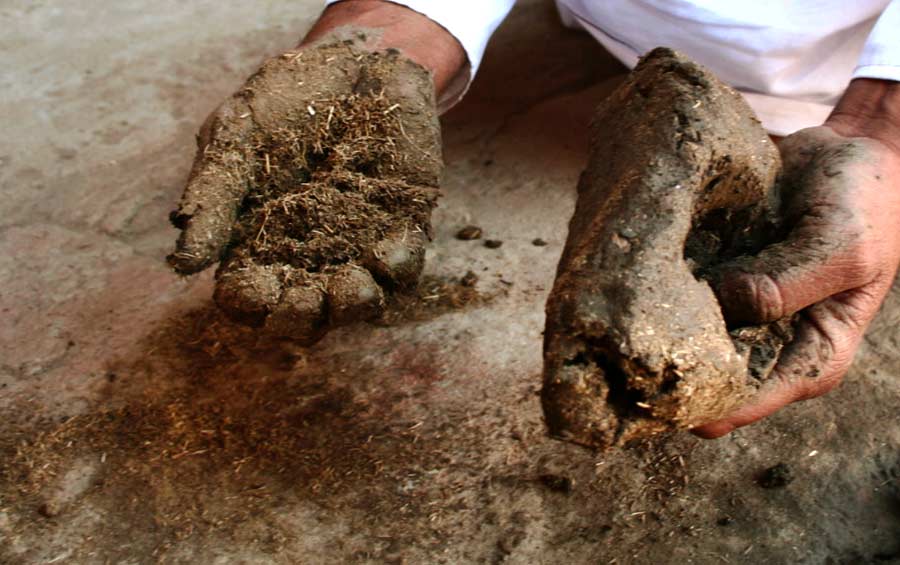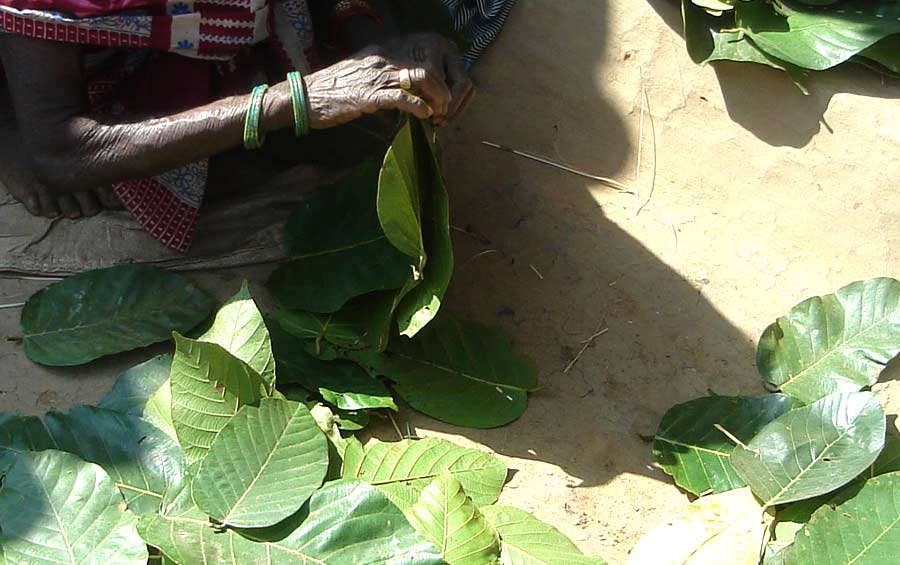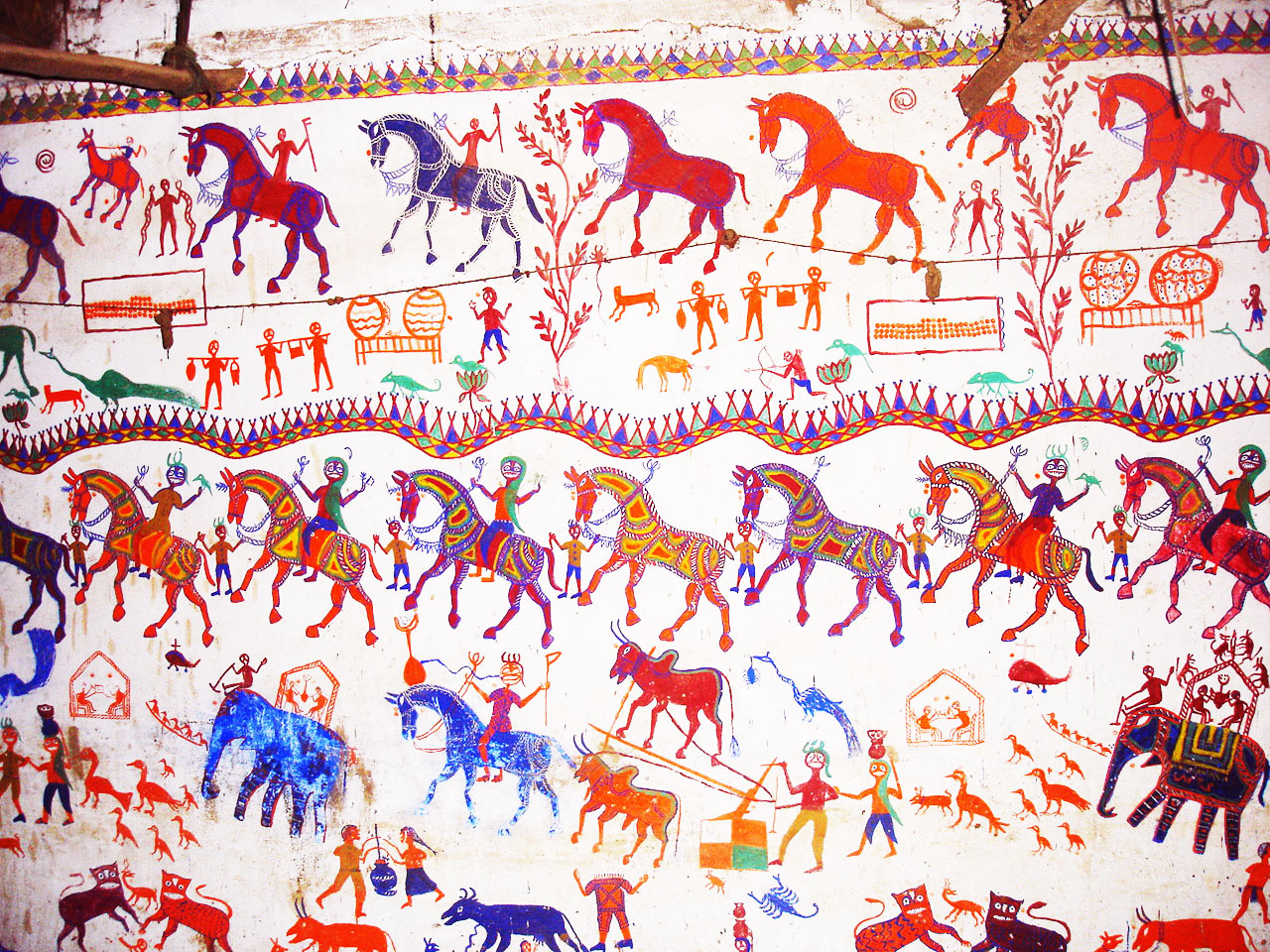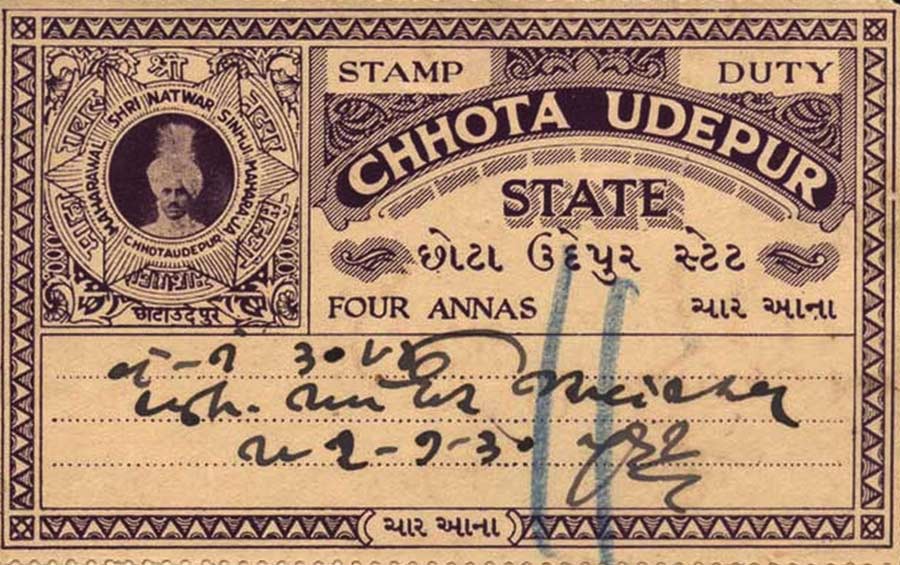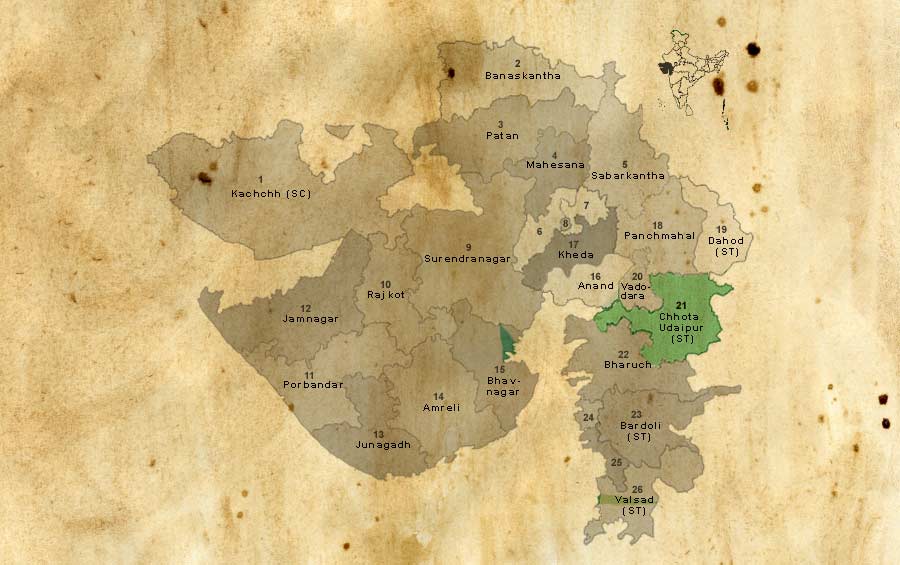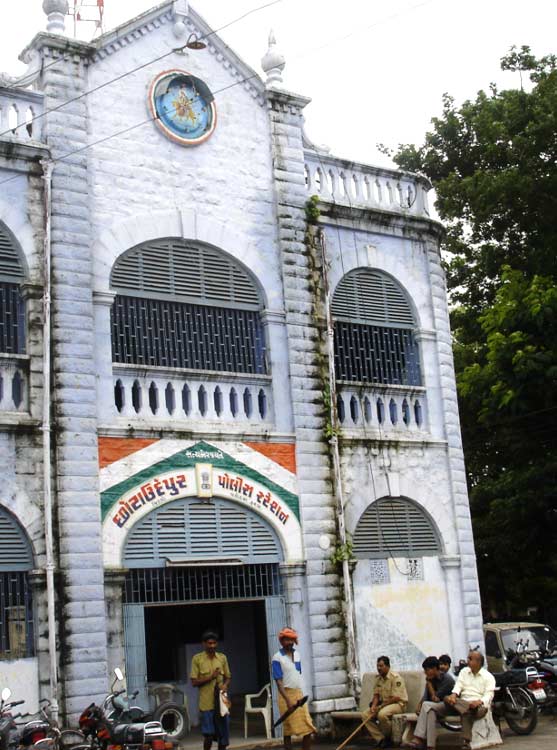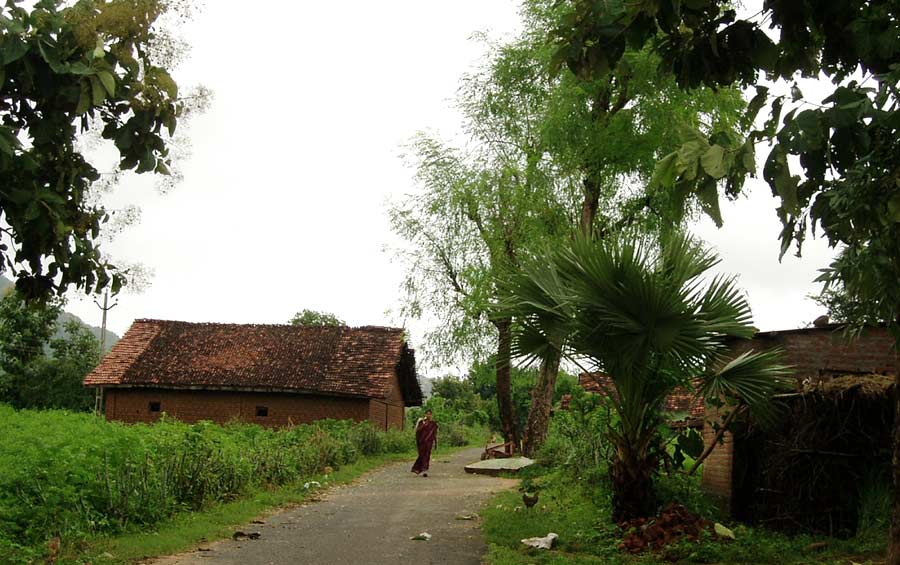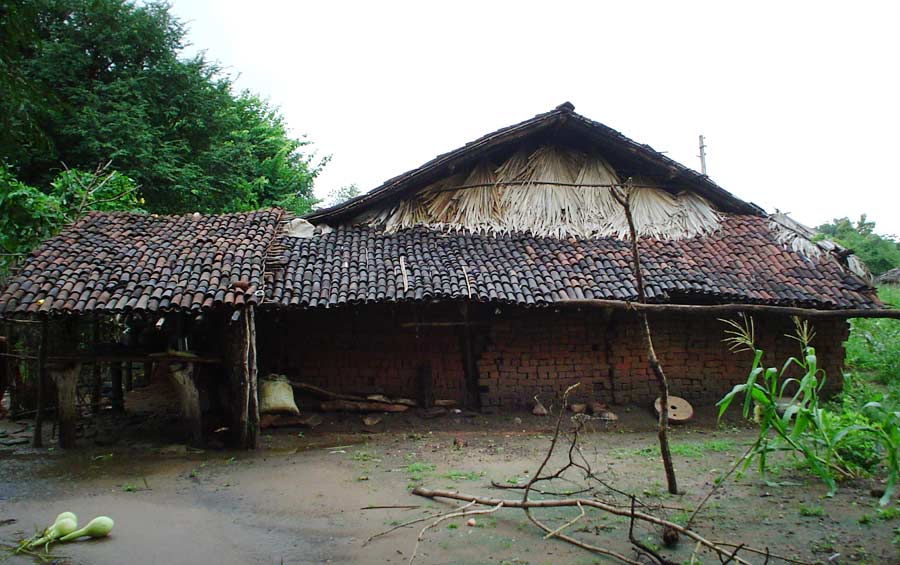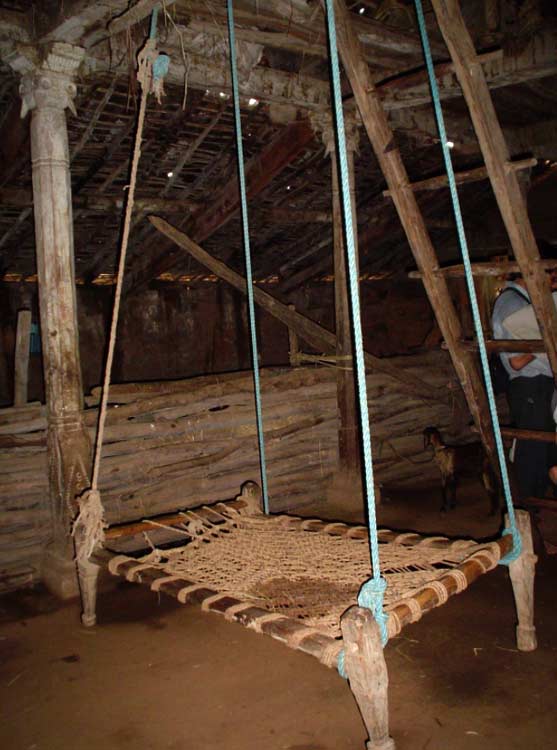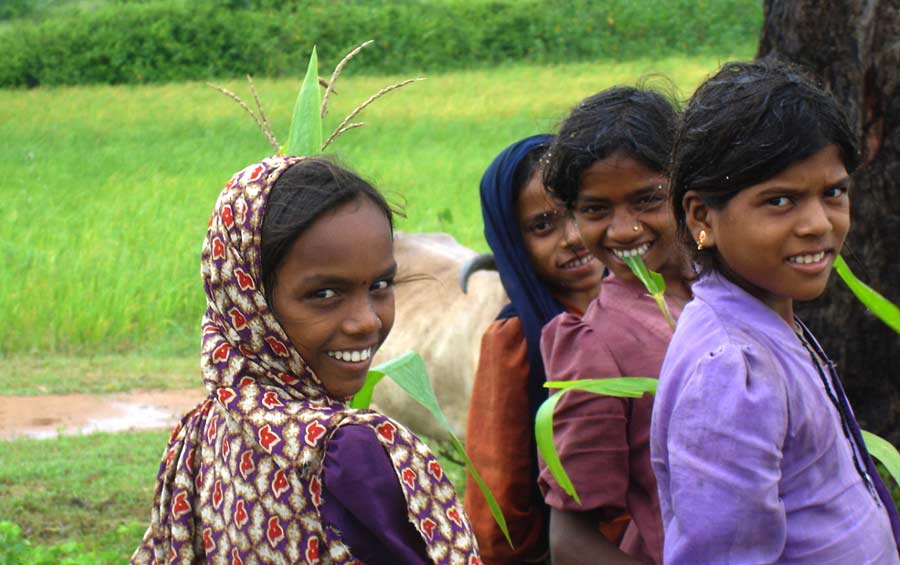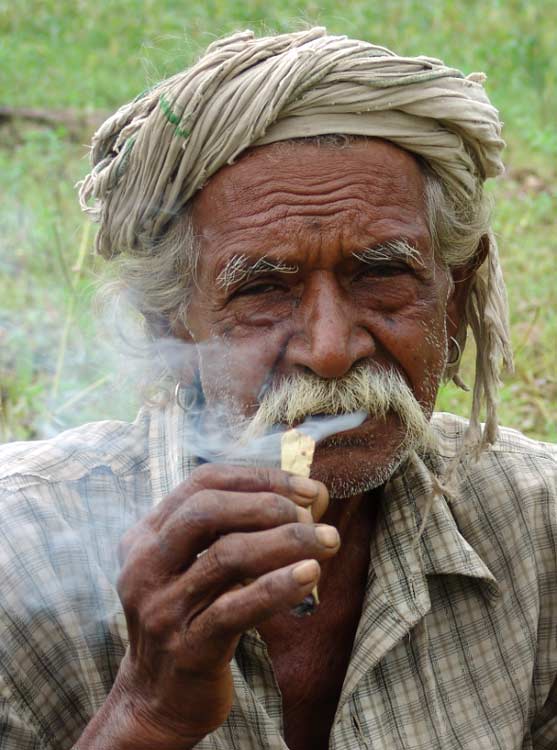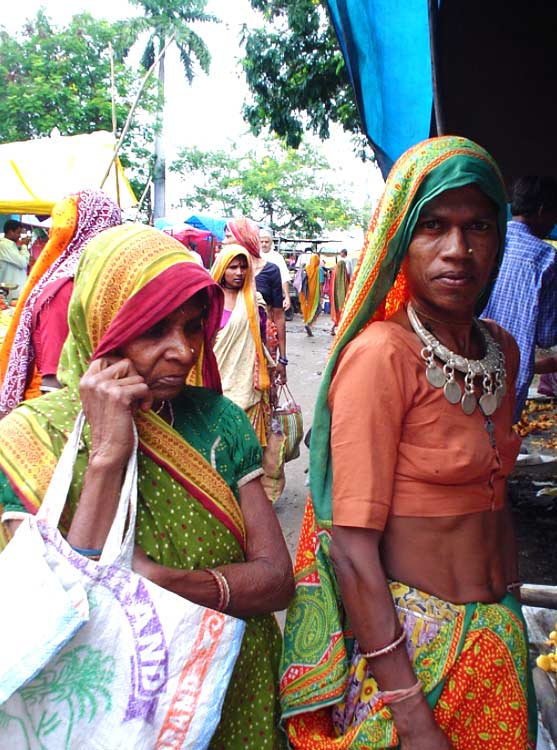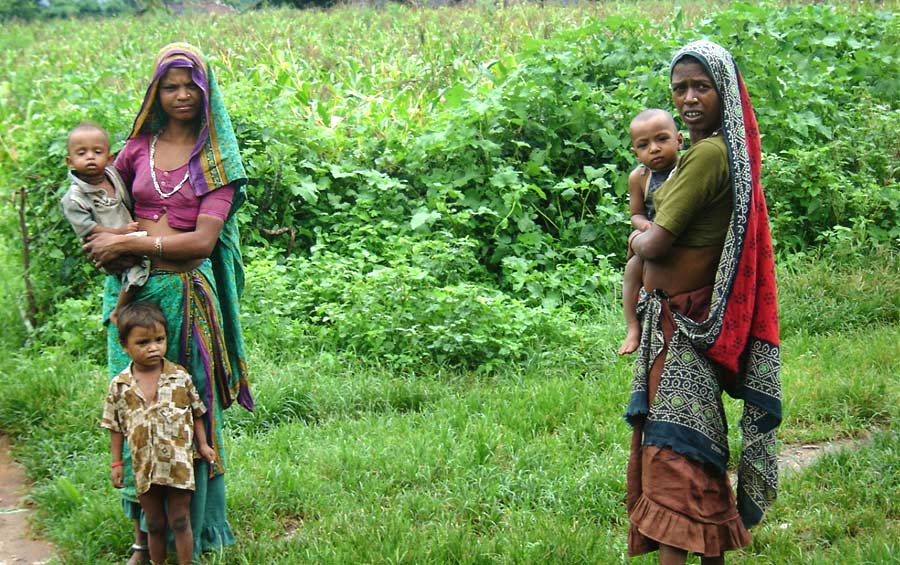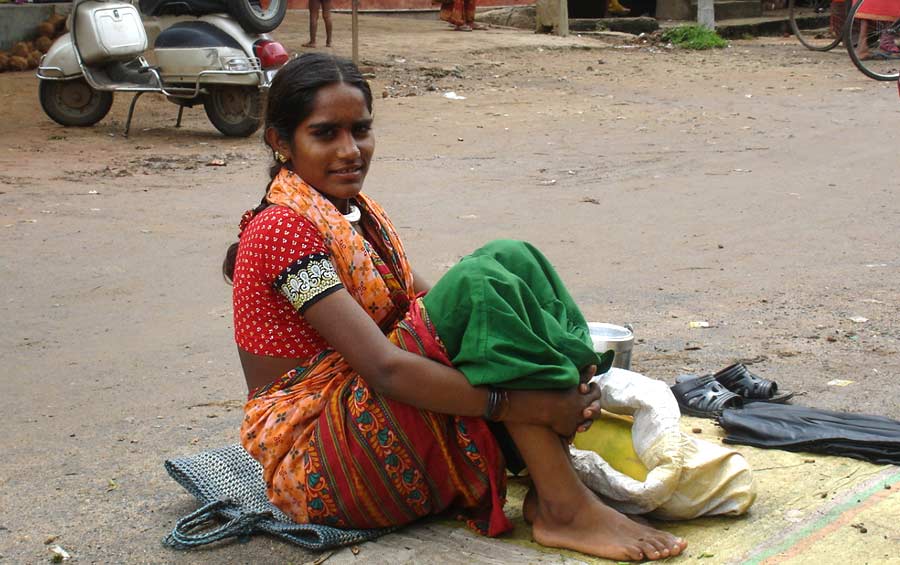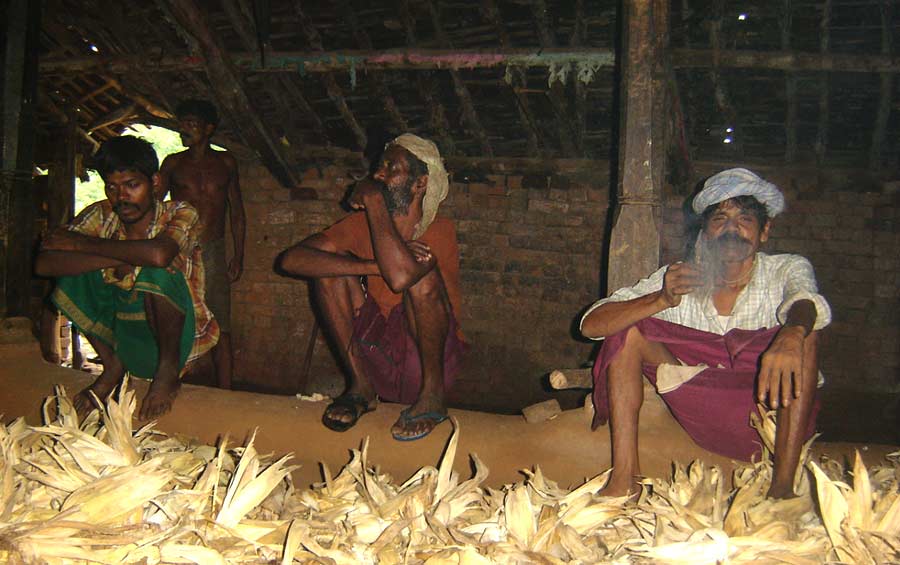Introduction:
Usage:
The Pithora paintings are done on the walls of Rathwa tribe dwellings as vows in a ritual. They were also believed to be used as maps depicted with codes. The tribes also paint their surroundings in vivid colours and in abstraction. Though the tribes consider it a divine painting and not used for commercial purposes, nowadays it is done on fabrics and also used as wall hangings.
Significance:
The Pithora paintings are abstract descriptions of the surroundings they live in. These are not literal depictions but of how they perceive the elements of their environment and nature. The recent ones also have modern elements like railway tracks, airplanes, and computers too.
These paintings are also considered to be highly sacred. The villagers consult a ‘Tantrik’ or a witch doctor of sorts to cure illnesses or release them from bad omens. They pray to ‘Baba Pithora’ and if the prayers are granted, they paint a Pithora painting on their walls in gratitude. This painting is also supervised by the Tantriks or priests. The completion of the painting is celebrated with ceremonies.
The presence of Pithora baba is considered auspicious in a household. A Pithora is always located at the threshold or the ‘Osari’, outside the first front wall. The Pithora artists are called Lakaras and the ones who keep an account of the paintings are called Jhokaras. Badwa or the head priests performs the rituals. When the ‘Lakharas’ paint, the ‘Badwa’, with his colleagues, sings and chants. In the evening before the sacrifice the priest goes into a trance and finds out what has been forgotten in the painting. That too is drawn and painted in. Most of the work is done by hand. Only men from the tribe are taught this art and allowed to paint. They are trained by the senior members from a young age.
Myths & Legends:
The story of the deity ‘Pithora’ is a very popular legend amongst the tribes in this regard.
King of Gods, Raja Indra had seven sisters. One day, one of his sisters, Rani Kadi Koyal went into the forest where she met Raja Kanjurana. She had an affair with him and after 9 months and 9 days, she gave birth to a son. Since she was still a maiden, out of fear of her brother, Raja Indra, she set the child afloat in a stream. That day Rani Kajal and Rani Makher (Indra’s other sisters) went to fetch water from the stream and found the baby crying. Rani Kajal fed milk of Akda / Banyan tree flower to the baby and bathed him with seven kinds of auspicious things. She named the baby “Pithora - and took him to the palace with her.
As the time passed, Pithora grew into a fine boy. One day when he was playing, he broke Rani Kajal’s earthen pot. This made her angry and she scolded him saying, “As it is, your maternal uncle holds the share of entire kingdom- She indirectly told him that Raja Indra is his maternal uncle.
Hearing this, Pithora decided to find out who his parents are. He went to Raja Indra’s court and introduced himself. After hearing his story, King Indra accepted him in the family with great joy and decided to find a suitable bride for him. But Pithora needed to know about his parents, if he wished to be married. So Raja Indra invited a grand court. He invited everyone; all the gods and goddesses, kings and queens, noblemen and respected citizens. When Pithora came in the court, he pointed at Raja Kanjurana and identified him as his father. After much rejoicing, a grand wedding ceremony was arranged and Pithora wed Pithori with much aplomb. All the gods and goddesses attended the wedding. They arrived on horses and elephants. Hence Pithora painting has gods arriving on horses along with Pithora and Pithori.
History:
The style of the Pithora paintings are believed to have originated for use in a sort of cartography. These maps were created in codes using abstractions for the natural elements around them by the tribes in Bharuch. It started in the 11th century when Bharuch was an important center for traders from the North. The roads and pathways were rugged and treacherous to travel in if you did not know them well. So the tribes took to escorting the Indian and foreign traders through Bharuch in exchange for silver coins, creating a niche profession for themselves.
To keep the land a mystery to the outsiders and make it easier for the locals, the tribal leader devised a method of creating a map with codes. Thus, the seven hills became represented by seven horses and the mouth of river Narmada by two tigers. The leader also ordered the escorts to make the same painting in their houses. The people who showed loyalty by painting the map at their home came to be known as “Rathwas- while those who disagreed, were called “Talavis-. The Rathwas then got rights to climb and dwell atop the seven hills. This practice went on till 1812 A.D. till the British rulers put a stop to it. Then the act of making Pithora painting became a ritual and Pithora became the god of Rathwa tribe.
Design:
The sacred enclosure contains the pictorial depiction of the mythology of the Rathwas. Generally the uppermost section of the enclosure, above a wavy line with geometric motifs, represents the world of Gods. Just below this line there is the procession of the marriage of Pithora and Pithori. The lower half of the enclosure depicts the actual myth of creation wherein the Earth, the mythical farmer, the cowherd, the kings, the Bania (trader/grocer), the Badvo, the goddesses of destiny, the cow and the bull, the various creatures of the forest and the minor deities are shown. The painters also include various other illustrations from regular life of Rathwas which cannot be seen in Pithora paintings from Madhya Pradesh.
In Gujarat region, Pithora painting has various connotations. One meaning attached to the Pithora Paintings is the idea of a map. This tradition is supposed to have started in the 11th century. The painting seems to be giving a map of the area where these tribes resided. There are various items present in the painting that prove this assumption.
The rectangular fence around the borders in the painting is assumed to be defining the geographical area over which the Rathwa tribe is spread. This rectangle usually extends up to the Arabian Sea in the west, Bharuch in south and Indore in north and east. The wavy line in the painting, dividing the painting is a representation of river Narmada. The seven horses depict seven hills present in the region. Things like fields, trees, farms, wild life, railway tracks are present in their relative positions in the map. Thus even in the literal sense, Pithora Painting depicts the world of Rathwa tribe. This deduction has been also possible by studying the socio-economical and political history of the region.
In middle ages, Bharuch was the “Gateway of India- for traders from the North especially, and Bharuch is present at the mouth of river Narmada . In those times, roads joining north and south region were very poor and also dangerous to some extent. As the adivasis were well versed with their region, they found an opportunity area which gave rise to a new profession: escorting foreigners as well as Indians to and from Bharuch through this region.
In those times, India had silver coins as currency. The escorts were from the tribes in this area. They were paid in monetary means that is; in silver coins. All this silver was collected in one place, mostly by the head of the tribe. The tribal people mystified the route of travel to ensure their income. They used the seven hills in this region to great advantage, as watch towers. They kept an eye on the travelers, controlled their movement, and frightened them.
The escorting happened till the onset of monsoon, when the trading did not take place. The tribes cultivated the land for four months till Dussehra. After Dussehra, the escorting started again and continued till Holi. The silver was distributed equally among the escorts on the auspicious occasion of Holi.
The leader of the tribe made a map of the region for the convenience of the escorts. There he showed the river Narmada with wavy line. The river mouth was indicated by painting two tigers. He showed the seven hills as seven horses. The tribals have no direct association with horses. He also ordered the escorts to make the same painting in their houses. To define the community of the escorts, the leader made a parallel of a state. The citizens of this state were called as “Rathwas-. All citizens showed their loyalty by painting the map on the wall at home. Only they were given the right to climb and dwell atop the seven hills. They were the ones who received the silver on the occasion of Holi.
The people who did not join the state and stayed at the foothills and were called as “Talavis-. They were not allowed to climb up the hill. Also, they did not hold any share in the collected silver. This practice went on till 1812 A.D. till the British rulers put a stop to it. Then the act of making Pithora painting became a ritual and Pithora became the god of Rathwa tribe.
Challenges:
Introduction Process:
Pithora paintings are created on the walls of the house chosen by the ‘Badwa’ (tribal oracle).Under his direction, the ‘Lakharas’ (tribal artists) make colorful pictograms depicting the wedding of ‘Baba Pithoro’ and ‘Pithori’. Other elements from the tribal way of living are also included in these colorful paintings.
Raw Materials:
Cow dung – The walls to be painted are coated with a mixture of cow dung and mud. This is the first step in the process called ‘Leepna’. This is done to temper the walls before painting begins.
Mud – A mixture of wet mud is used along with cow dung to coat the walls as a base for the painting.
Plaster or white chalk powder – This is used as a second coat in ‘Lipna’ and is done over the cow dung and mud layer.
Mineral colors – These are available in powdered form and prepared by mixing it with milk and ‘Mahuda’, local liquor extracted from the ‘Mahua’ tree.
Poster Colors – Since the last quarter of the century poster colors are being used as they are easily available and are slowly replacing mineral colors. The main colors used are red, vermilion, orange, yellow, indigo, ultramarine, green, silver and black.
Paper or fabric – As the craft has grown in popularity these are used as canvases for commercial purposes.
Khakhra leaves – These are used to make paint mixing bowls.
Khakhra stems – The stems of the ‘Khakhra’ plant are used to make brushes.
Mahua – This is a local liquor made from the extracts of ‘Mahua’ tree.
Milk – It is mixed with ‘Mahua’ and pigments to create colors for painting.
Tools & Tech:
Brushes –These are made from the stems of ‘Khakhra’ plant.
Bowls –These are made from the leaves of ‘Khakhra’ plant and are used for mixing paints.
Canvas –The chosen walls of the house are used as a canvas. Nowadays, paper and fabric are also used.
Rituals:
1. Pithora painting is not done for any decorative or ornamental purpose. Pithoro, or ‘Babo Pithoro’ as the tribals would call it, is an important deity in a region where several deities are worshipped. If someone, especially a young child or an unmarried girl is unwell or domestic animals are affected by an epidemic or if the land is not yielding enough- all believed to be signs of god’s anger or displeasure-the head of the family vows to provide a proper, respectable abode to ‘Pithoro’ in his own home. He therefore gets ‘Pithoro’ painted (or repainted, if there already is one) on the main wall, if and when he can afford the high cost involved.
2.’Pithora’ Painting can be called a ritual rather that an art form for it is “performed- to thank God or for a wish or a boon to be granted. A comprehensive understanding of this ritual will call for a narrative- the head priest of the community who is called “Badwa-, is summoned when a problem occurs in a family. The problems are narrated to the Badwa ” who offers solutions, which almost always involves the painting of ‘Pithoras’ on the walls of the house.
The Pithora Baba is considered to be the reigning deity of the community and his presence is considered to be the solution of all problems. The first wall of the house is considered to be the right place for a Pithora.
A Pithora is however, considered to be a three-wall affair, so the first wall and the other two walls around it are prepared for the painting.
The walls to be painted are first plastered with mud and cow dung by the unmarried girls of the household, and then coated with chalk powder this process is called ‘Lipna’. And then the painters proceed to do their work.
In the forest clearing they dance; men and women, boys and girls, to the pulsating rhythm of the mandals and the echoing pipes. The musicians play faster and faster, the dancers get into a frenzy and all of a sudden, some of them roll on the dusty ground. As they do so, calves charge in and trample on them. When the ritual is over, the dancers rise unhurt. The tribals believe that they have been cleansed of their sins by the grace of the Goddess. These and other tribal rituals mostly form the themes for traditional Pithora paintings.
When finally the painting had finished, a branch from the “Karam- tree was taken and fixed on the ground, in front of Bhadu’s house. Now it was time for starting the ceremony. Obviously this could not start without Kochar kaka. So he initiated the process. Both Kochar kaka (or Badwa ) and the Lakharas belonged to separate villages and they tested each other’s authenticity. After some time, when the ceremony got a little more intense, Kochar kaka started taking incarnations of various beings. He first took an incarnation of a woman, then of a farmer, a hunter, a washer man, a barber, a man, a monkey, a water bearer. The others danced outside the house. The pooja ceremony went on for the entire night.
After all this was over, to finish all the rituals, it was important to sacrifice some animals. So as a result, 7 goats were sacrificed from within Bhadu’s house. 6 more goats were sacrificed, that were got by his relatives. Also, 7 cocks were sacrificed. The heart of these sacrificed animals was served to the gods along with liquor, “Urad- pulse and kept along the holy fire.
At the end, all the guests were served the meat. It was only after serving everyone could Bhadu’s family eat, so they ate at the end.
Also, if any time in life Bhadu was to shift to a new place, he would have to make this Pithora painting all over again. And also, no girl could touch the painting, and no one could go near the painting with slippers on. Mostly, after every 8 years, this process had to be repeated. This was called the “Pangu- ceremony.
process:
Pithora paintings are created on the walls of the house chosen by the ‘Badwa’ (tribal oracle).Under his direction, the ‘Lakharas’ (tribal artists) make colorful pictograms depicting the wedding of ‘Baba Pithoro’ and ‘Pithori’. Other elements from the tribal way of living are also included in these colorful paintings.
Color Preparation : Mineral colors and natural pigments are used to create paints, though nowadays poster paints are also used. These are mixed with milk and ‘Mahua’ which is a local liquor made from the extracts of ‘Mahua’ tree and kept in separate bowls made from ‘Khakhra’ leaves. Red, vermilion, orange, yellow, Indigo, ultramarine, green, silver and black are the major colors used.
Wall Preparation : The painting process involves a long ritual celebration a day before painting where the walls are white- washed. As Tuesday is usually picked for this white wash ritual, the day has locally been named ‘Pandudio’ or whitening day.
Before painting begins the ‘Badwo’ selects the walls of the house on which the ‘Pithoras’ will be created. Purely for reasons of respectful hierarchy, the largest wall in the house is chosen to create the main ‘Pithora’ and the adjacent walls serve as extended canvas. These walls are cleaned and readied for painting.
Mud, cow dung and white chalk powder are brought in five new (unused) baskets covered with new (unwashed) pieces of cloth.
Before painting begins a base layer of cow dung and mud is coated on the walls followed by a layer of white chalk powder or white plaster. The raw materials for this are brought in five new (unused) baskets covered with new (unwashed) pieces of cloth.
This process called ‘Leepna’ follows strict religious protocols wherein only unmarried adolescent girls of the house can participate. The process of ‘Leepna’ is done to temper the walls and create a white canvas.
As the girls perform the ‘leepna’, the ‘Badwo’ lights ‘Diyas’ (earthen lamps) and prays to the God for the wall’s purification. After the purification process is over and the wall has dried, with the blessings of the ‘Badwa’ the ‘Lakharas’ (pithora painters) begin painting.
Painting Begins: The Lakharas begin painting the stories
The painting is supervised by the tribal priest while the artists go about it. The stories and symbols are painted in, taking about a day to finish. Stencils are mainly used for the body of the horses and the figures. Most of the drawings and outlines are done by hand. After it is drawn they make an outline with a bamboo twig, and fill it with color. At the end, they finish with silver color or some bright dots or lines. Celebrations and ritual offerings follow the completion of the painting.
Waste:
Cluster Name: Chhota Udaipur - Chhota Udaipur
Introduction:
District / State
Chhota Udaipur - Chhota Udaipur / Gujarat
Population
Language
Gujarati, Hindi
Best time to visit
Augest - March
Stay at
homestays or government guest houses
How to reach
It is situated 100 Km. from Vadodara, Taxi or bus
Local travel
Auto, walkable distance
Must eat
khichdi, Kachori
History:
The region was inhabited by Rathwa tribes since ancient times. The Royal state of Chhota Udaipur was founded in 1743 AD by Rawal Udey Singhji, a descendent of Patai Rawal of Champaner. The Inscription studies show that the founders of Chhota Udaipur kingdom were direct descendants of Maharaja Prithviraj Chauhan. It is believed that, Khichi Chauhan Rajputs moved to the Pavagadh Hill via Malwa just after their battle with Muslim invaders. Initially they established a capital at Mohan near Narmada and eventually moved the capital to Chhota Udaipur. After a treaty was signed with British army, the city attained peace. The kingdom became a part of Union of India on March 10, 1948 AD. It was carved out of the Vadodara district on January 26, 2013 with its headquarters at Chhota Udaipur town and is the 28th district of Gujarat.
Geography:
It is situated 100 Km. from Vadodara. The local administration of the area is looked after by the Municipality. Chhota Udepur district has a forest area of 75,704 hectares and has deposits of dolomite, fluorite, granite and sand all of which are mined. The district is also home to a large dairy industry.
By road: Vadodara, 112 km from Ahmedabad and 420 km from Mumbai, is located on National Highway 8.
By rail: Vadodara, a major railway junction is located on the Western Railway, which connects Mumbai, Delhi and Ahmedabad. Tribal Chhota Udepur and Vadodara are now connected through a new railway line
By air: Vadodara is connected by various domestic airlines to Ahmedabad, Delhi, Mumbai, Daman, and Pune.
Environment:
Infrastructure:
Chhota Udepur is a district head quarter. Besides government offices, the town has a big post office, major Indian banks, ATMS, a hospital and a Bus stand. The town's main ornament is the lake which is situated right at the center of the town. Every Saturday, a haat bazaar is organized around the lake; people from nearby villages come to indulge in their weekly shopping. The town also has guest houses to accommodate travellers and researchers. The town is in close proximity to Vadodara, which has almost all facilities. Those visiting the town in groups should opt to stay at Bhasha institute at Tejgarh, which is at 12.8 km distance.
Architecture:
The town has a mix of monumental and vernacular architecture. Many buildings date back to pre-colonial period, which are now being used as offices. Flat roof architecture is prevalent in the town and many new multi storey buildings are being made. Some of the old buildings also have conical roof with clay tiles. In the farmlands surrounding the town, the tribes live in houses made of bricks with bamboo frame as ceiling which is covered with clay tiles. These houses often have a fenced backyard for keeping livestock.
The Ratwa villages have open ground in front which is called as Gondhro, this is used for various festivities, ceremonies and a grazing ground for cattle. The boundary of such villages is called 'him'. The guardian deity of Himodi protects the village and the villagers often gift clay tigers to this goddess.
Culture:
People:
The region is inhabited by local tribes such as Rathwa, Bhil, Bhilala etc. Rathwas have long inhabited the region and constitute the major part of population in Baroda, Panchmahal, Chhota Udepur and Alirajpur districts. Their mythology is greatly influenced by Geography of Madhya Pradesh and one can find several references to Malwa horses, land of Dhar and Raja Bhoj of Dhar district. The tribe speaks local dialect of Rathwi which is a mixture of Gujrati, Malvi, Marathi and ancient Bhil dialect. The traditional occupation of Rathwa tribe is farming; they practice small scale farming by slash and burn technique which involves burning of a patch of land and then digging to sow the seeds for new crops. They still use plough and pair of bullocks to cultivate the lands and rain is their major source for irrigation. When not doing farming, the families employ themselves as laborers in nearby towns. Hunting, fishing in nearby streams and cattle rearing are other ways of obtaining livelihoods for Rathwas.
The Rathwas are classified into several exogamous clans such as Katolia, Changol, Dovda, Punjara, Sadariya, Haraya, Oharia, Damor, Tadvi, Basia, Bamania etc. Marriages within the same clan are prohibited and majority of marriages happen by mutual consent. A sacred sweet Jaggery is distributed in village by groom’s father when the couple has mutually agreed upon the nuptial knot and wedding ceremony is arranged at girl’s residence.
The chief religious practitioner of the clan is Badvo (Shaman). All the religious and ceremonial activities are carried in the presence of this chief. He also has a great influence over social and financial matters of the village. The problems of diseases, burglary, sterility of women and livestock, crop failure and natural calamities are often consulted with Badvo. He is the also considered as an interpreter of supernatural occurrences.
The chief deities of Rathwa tribes are the spirits of their ancestors, they also believe in Gamdev ‘Village god’, Himodi ‘the goddess of village boundary’, Khetarpal ‘field deity’, pithoro ‘god of foodgrains’, Ind and Hadhol ‘pithoro’s assistants’, bhehato ‘protector of buffaloes’, Babo tundvo and Ai tundvi ‘two hills which are considered gods’, the sun, the moon.
Famous For:
Craftsmen
List of craftsmen.
Documentation by:
Team Gaatha
Process Reference:
http://books.google.co.in/books?id=lBXdIQVeIS0C&pg=PA99&lpg=PA99&dq=rathwa+tribe&source=bl&ots=KPTRbdfwcI&sig=mqcwMLpgdaS8DPlQ1PFM_FZNMYE&hl=en&sa=X&ei=mAtzU46gEdWNuATm3YHADw&redir_esc=y#v=onepage&q=rathwa%20tribe&f=false
Cluster Reference:



